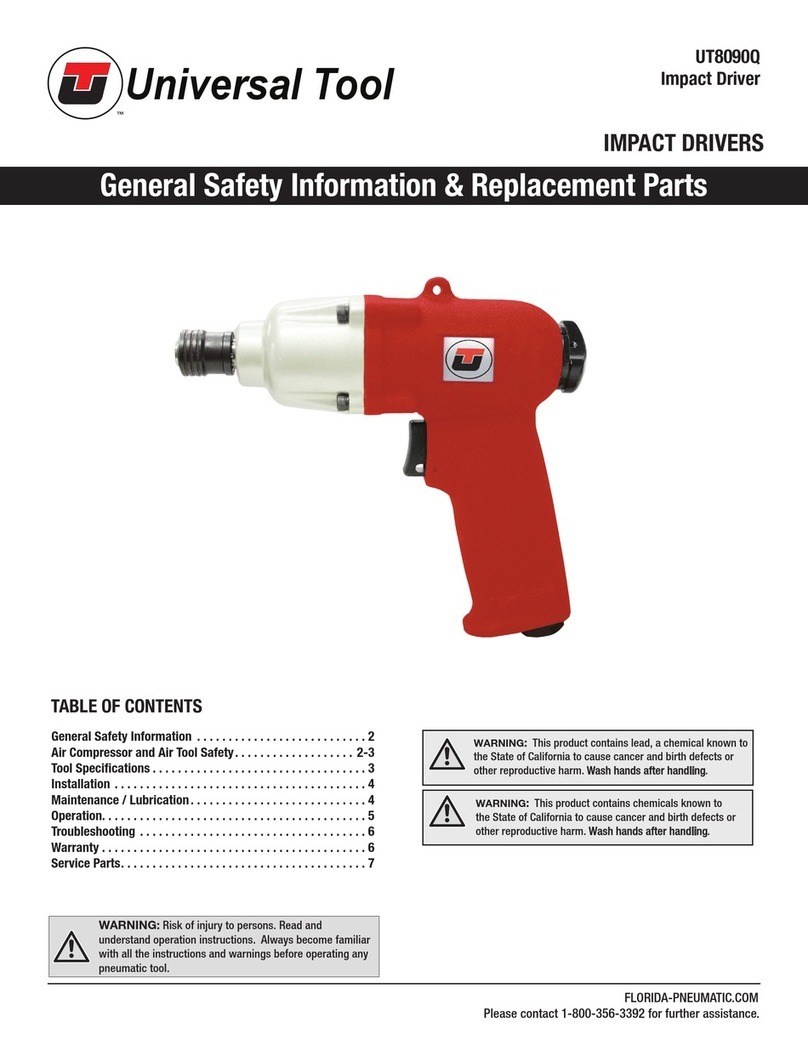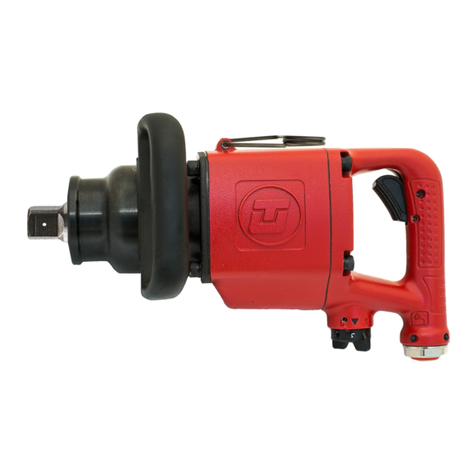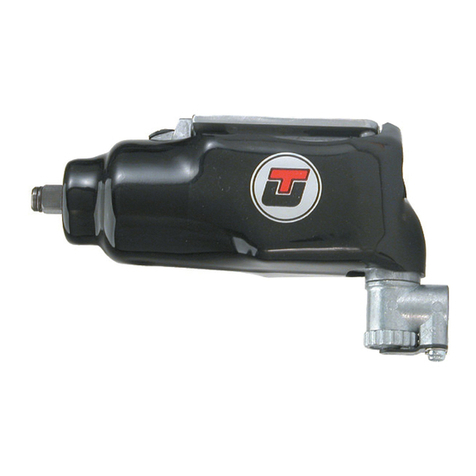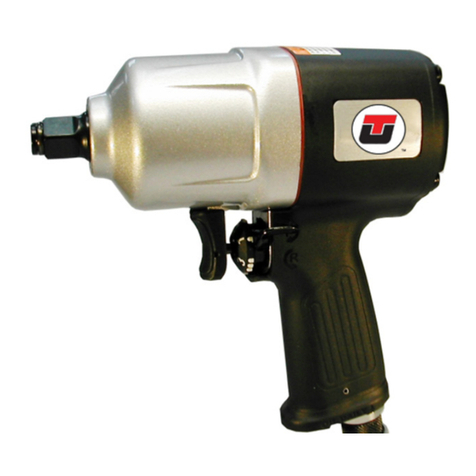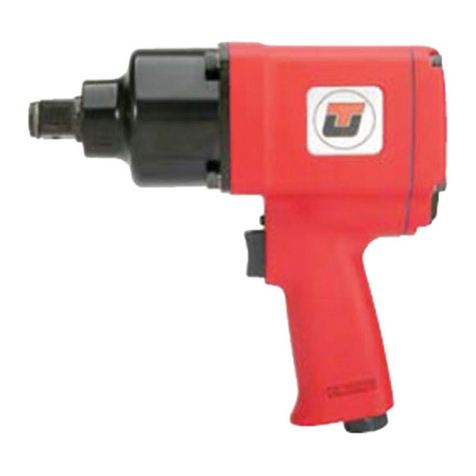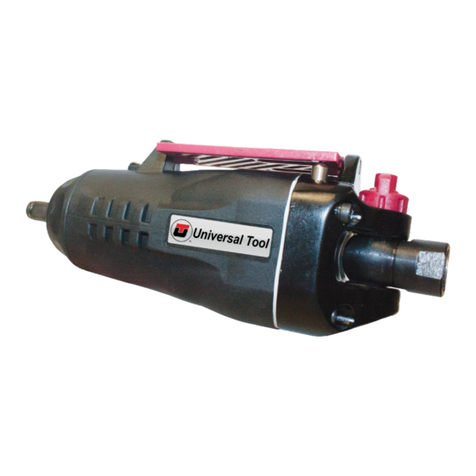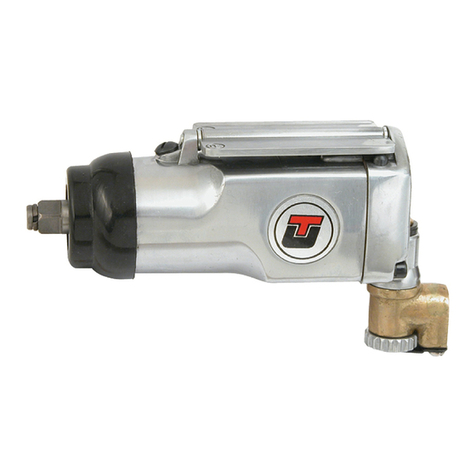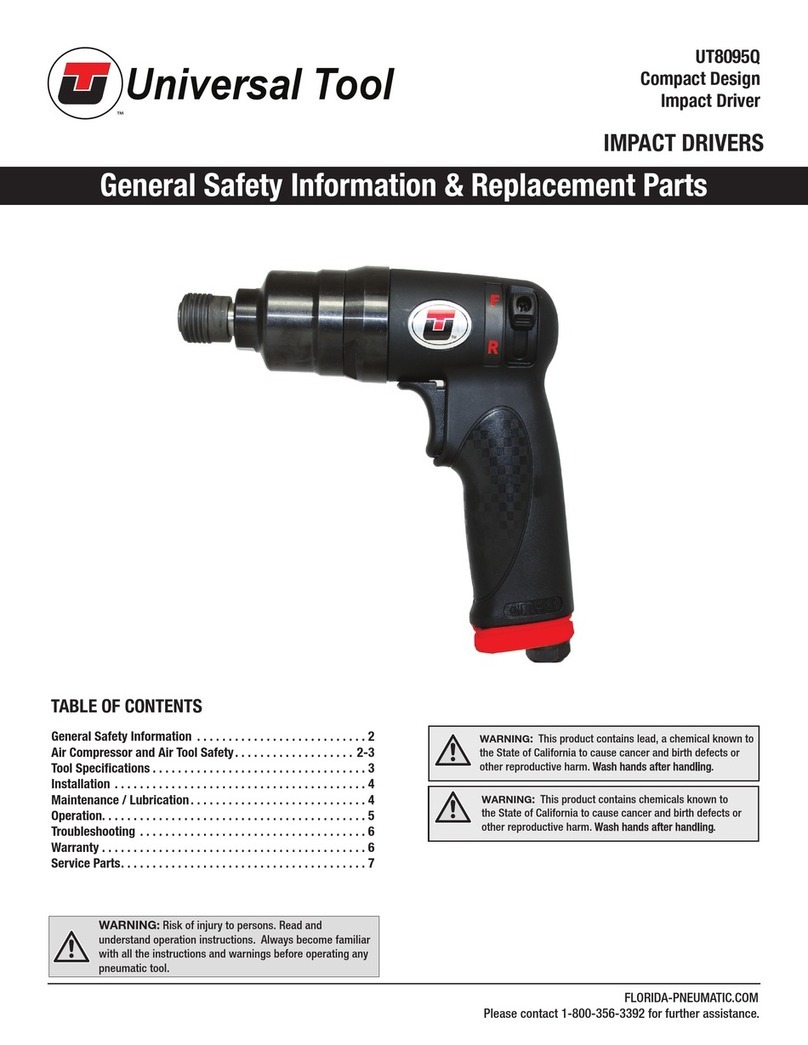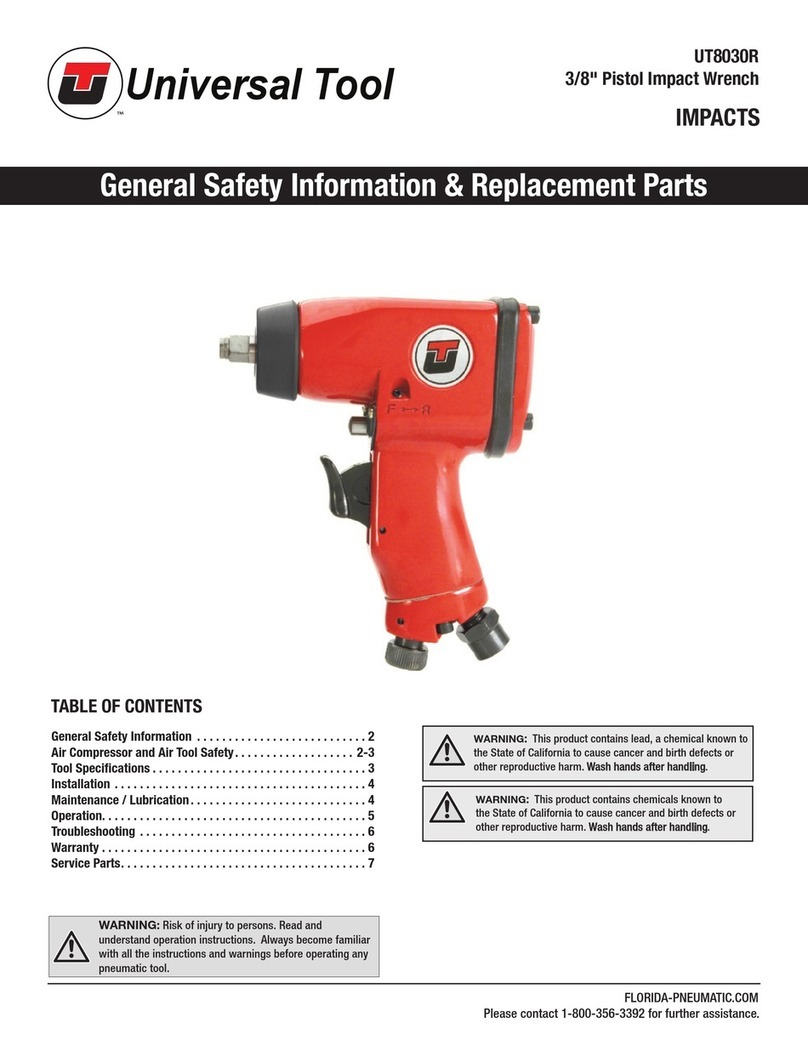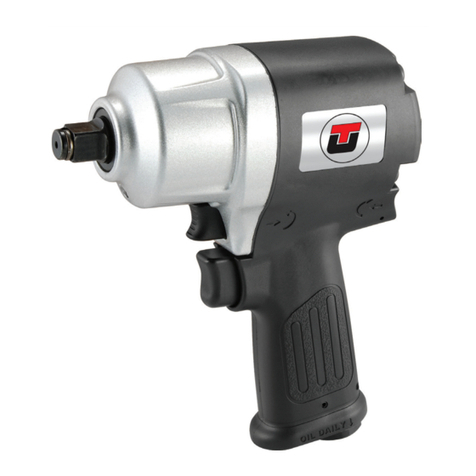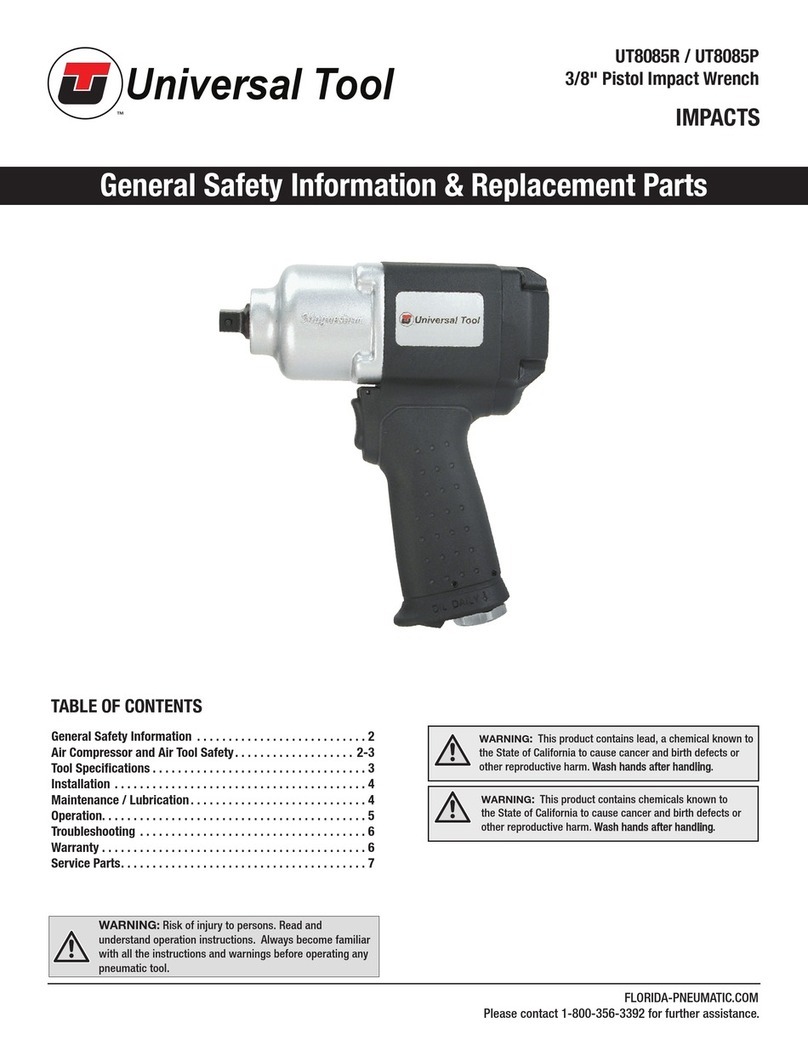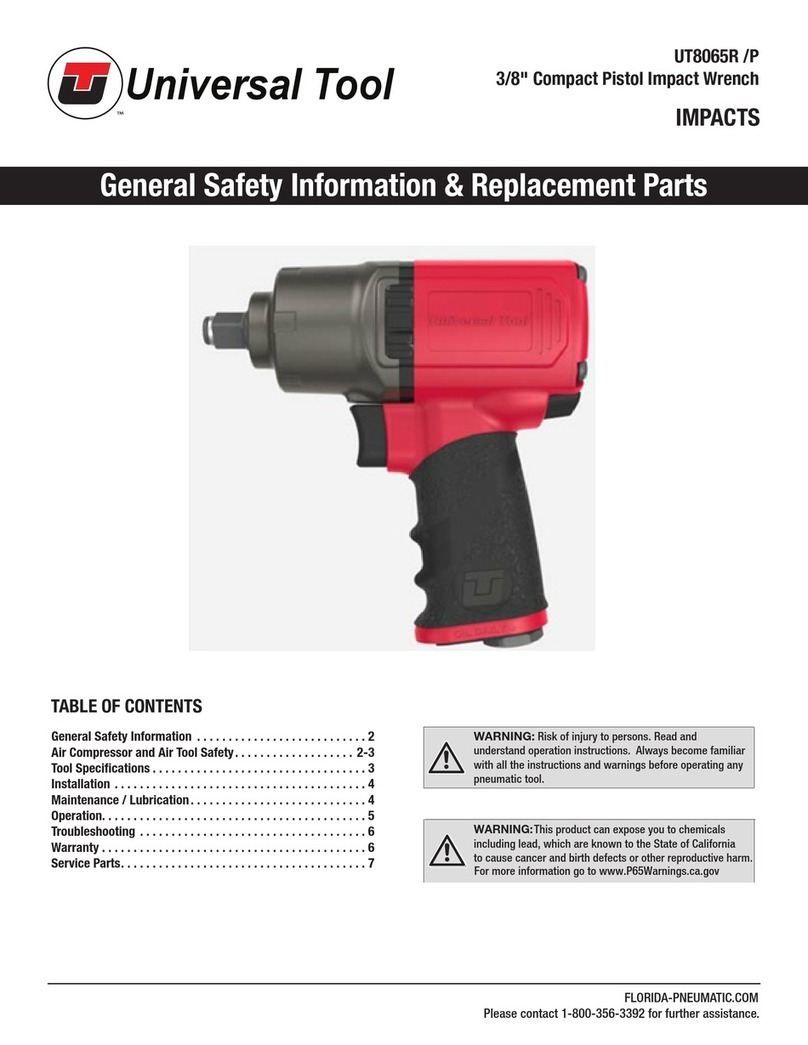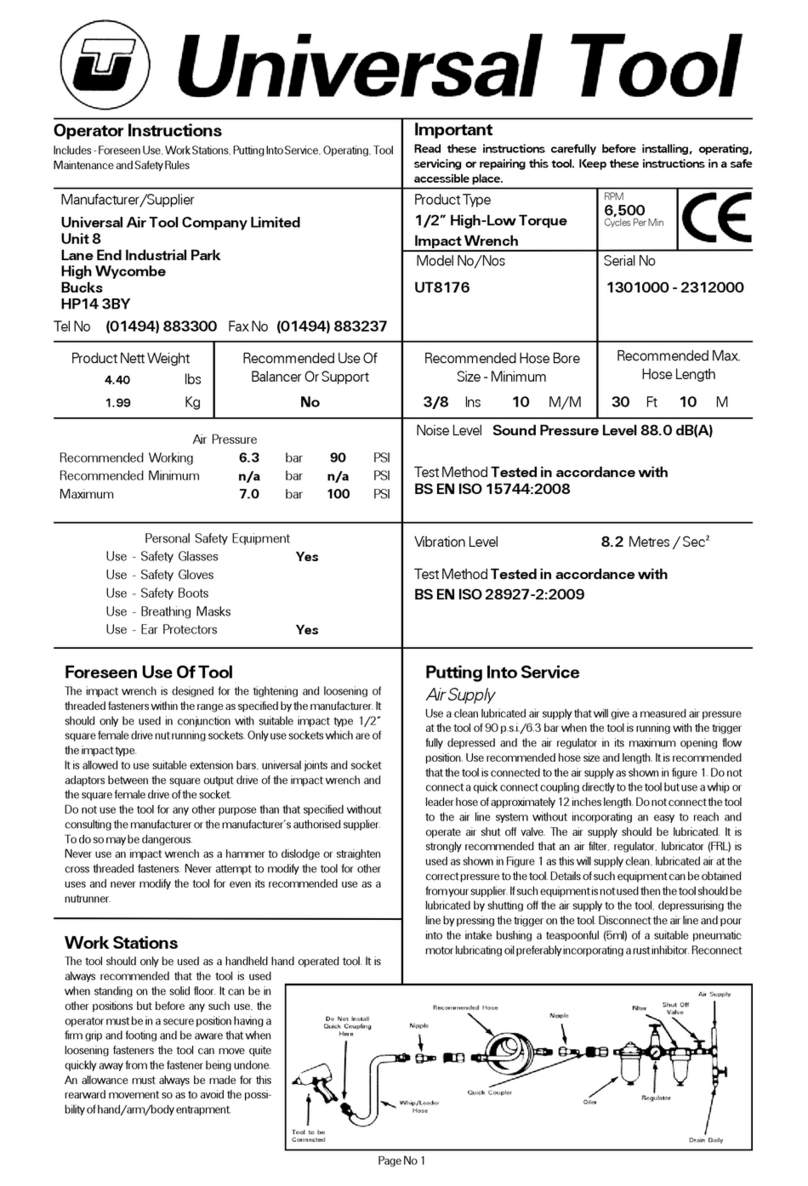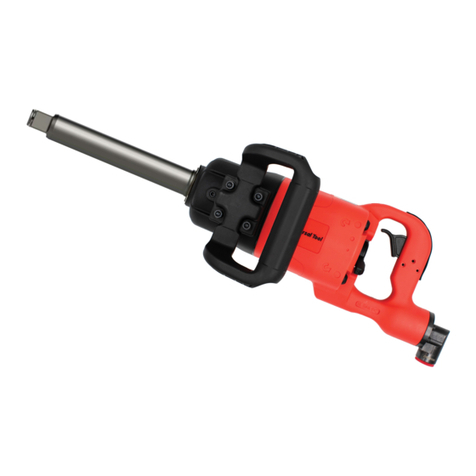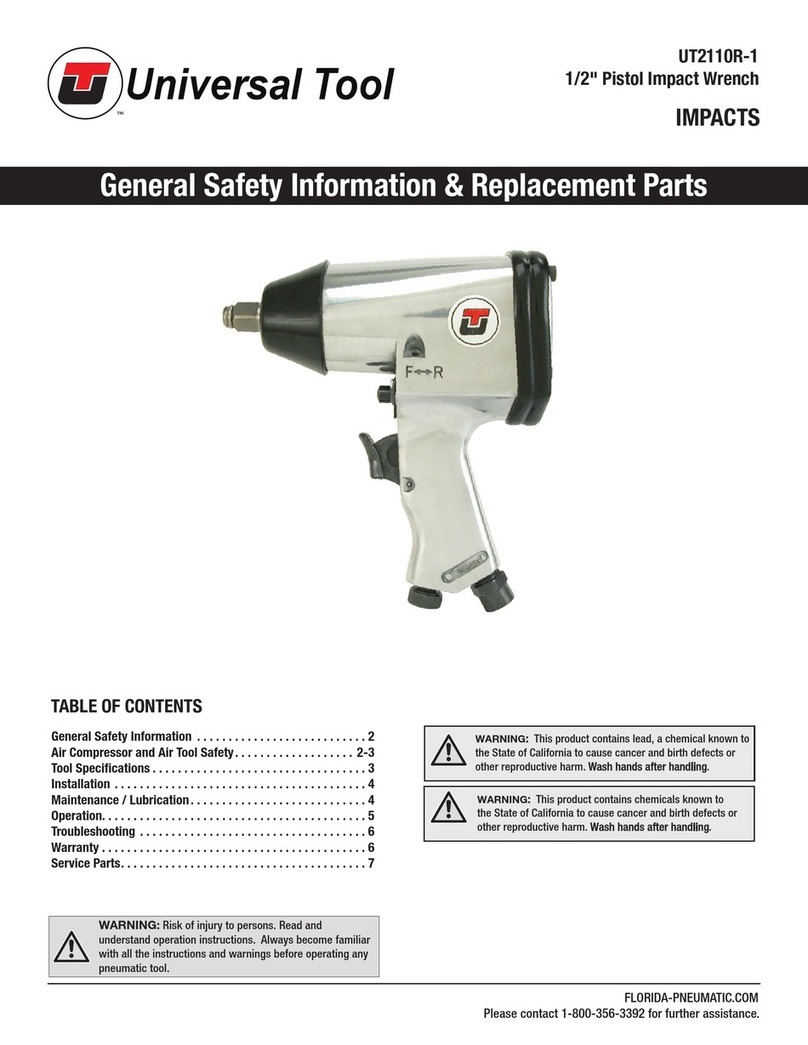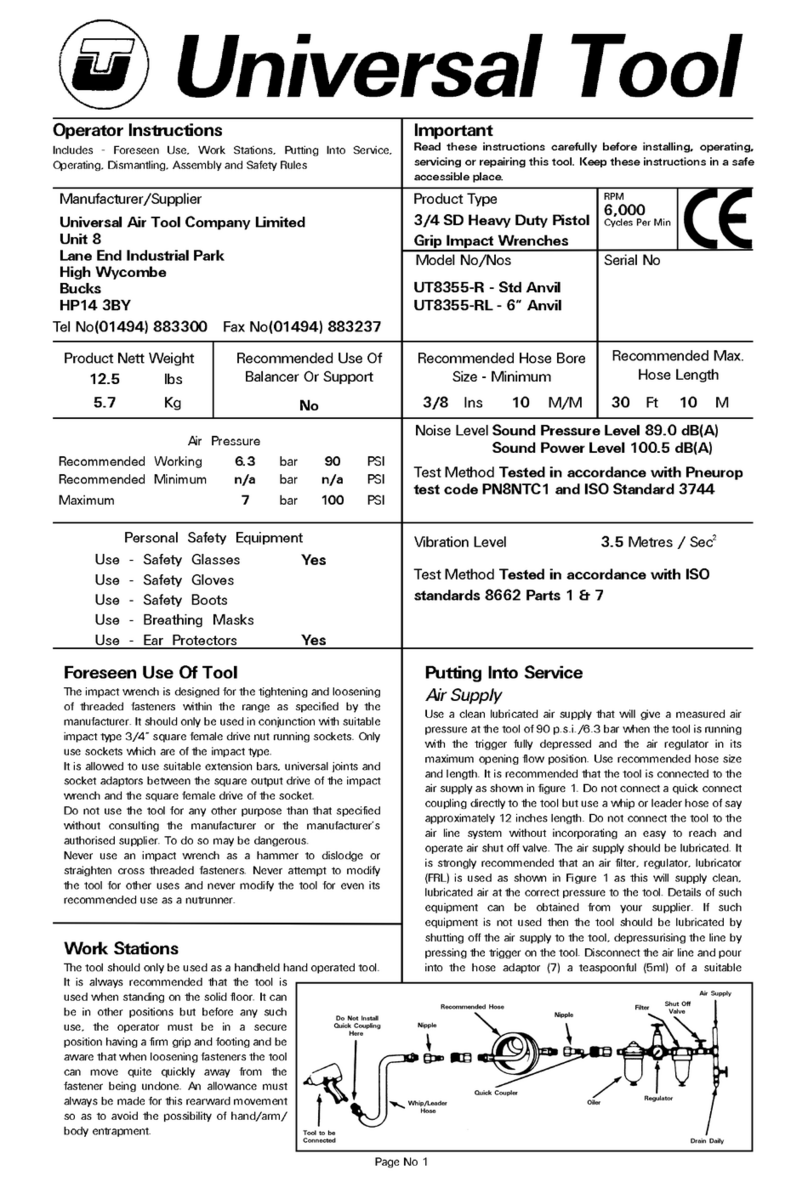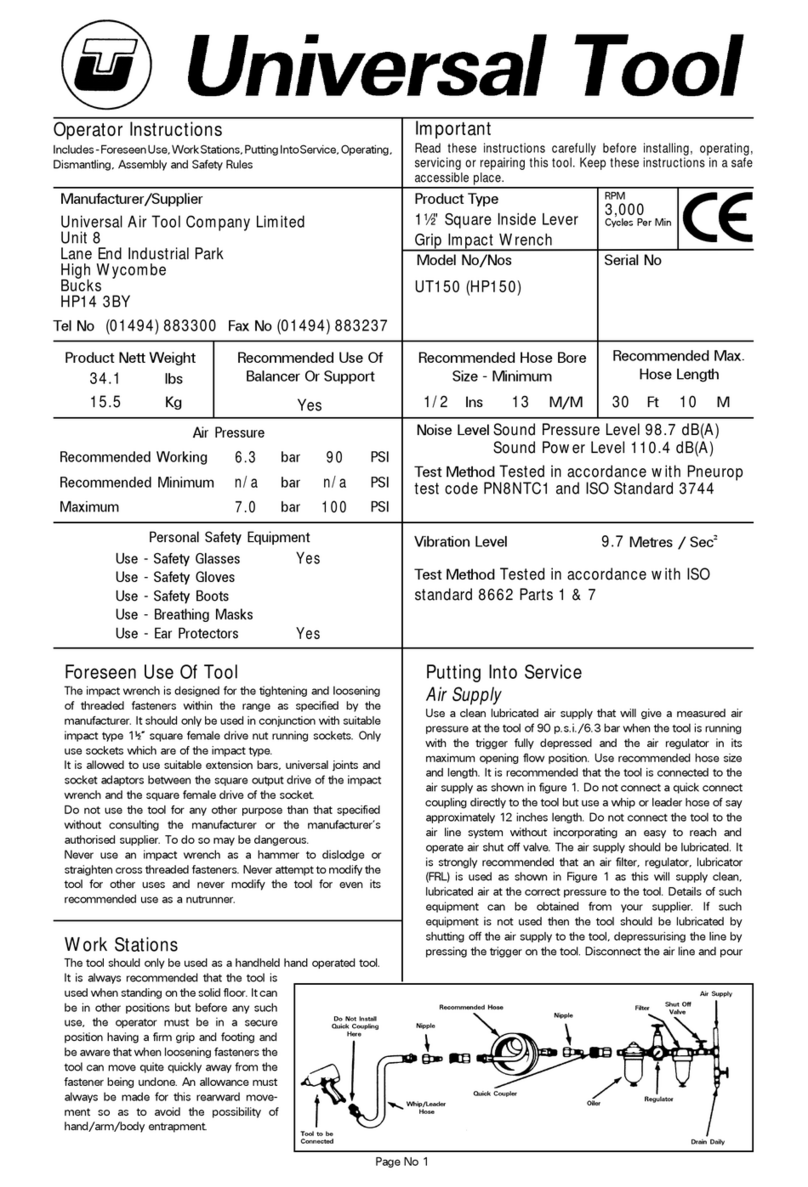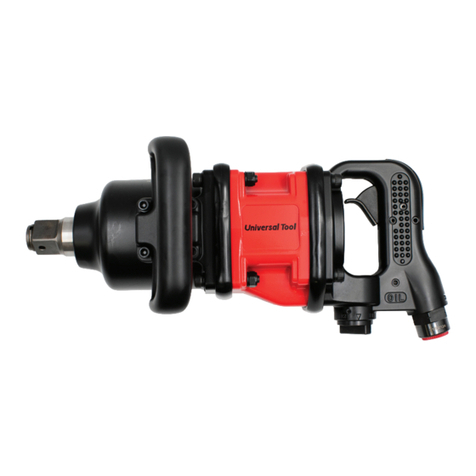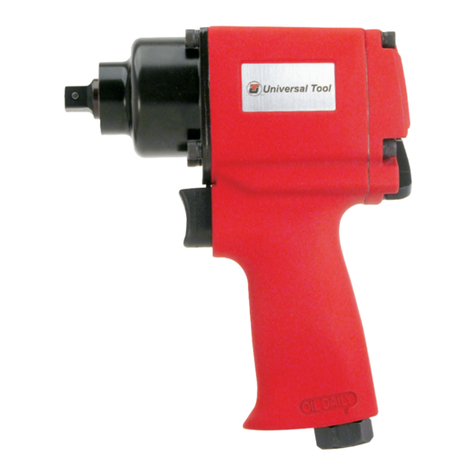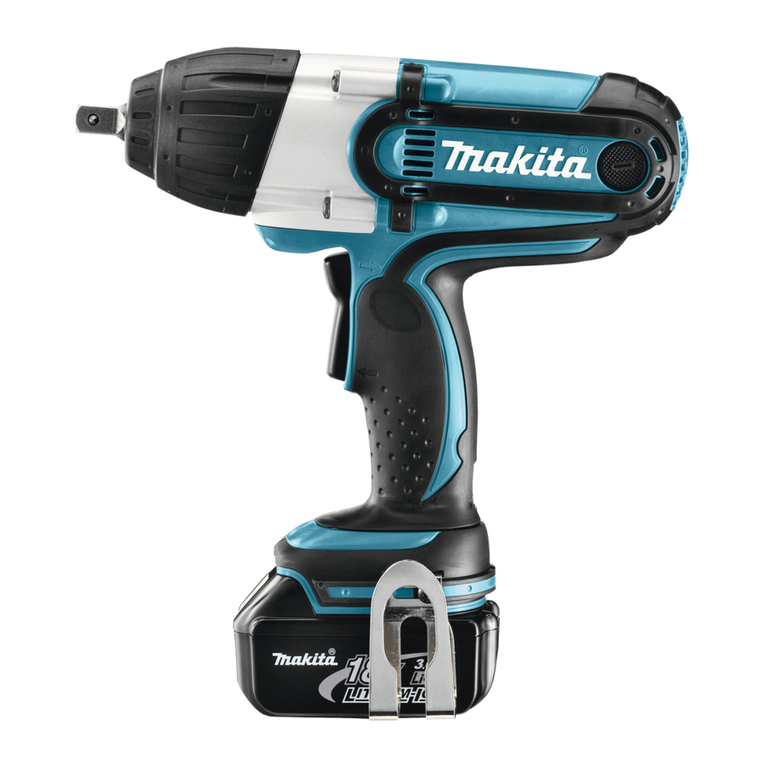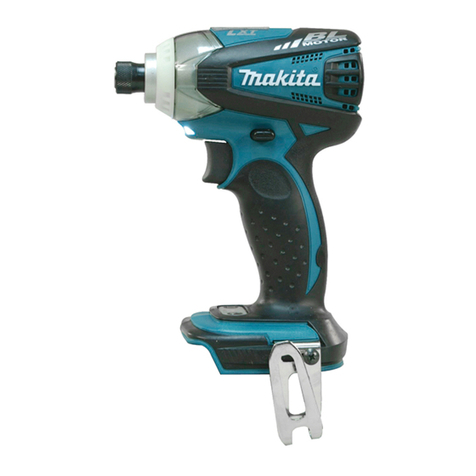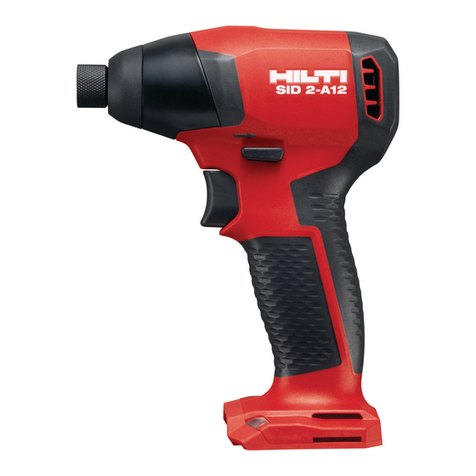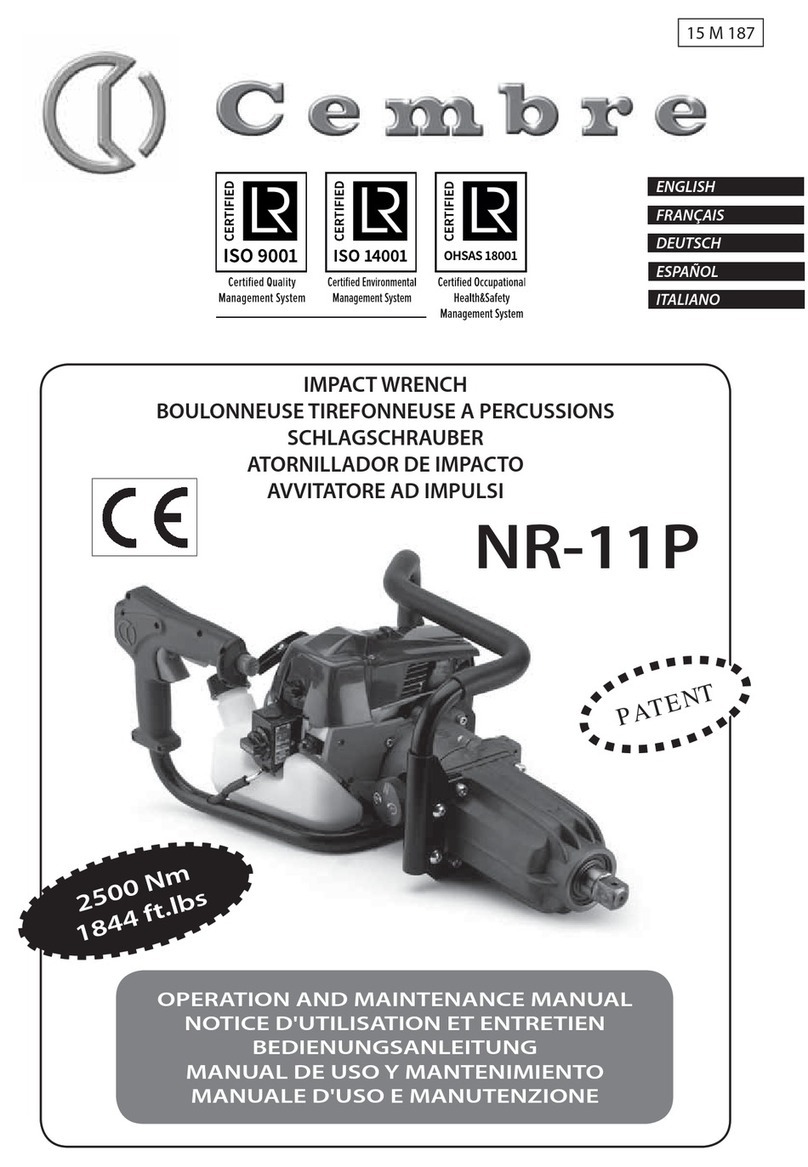
Operating
The output of the impact wrench in prime working condition is
governed by mainly three factors
a) the input air pressure
b) the time the impact wrench is operated on the joint. Normal time
for joints of average tension requirement 3 to 5 seconds
c) the setting of the air regulator for a given joint at a given pressure
operated for a given time.
The air regulator item (19) can be used to regulate the output of the
impact wrench if no other control means is available. It is strongly
recommendedthatanexternalpressureregulatorideally aspart ofa
filter/regulator/lubricator(FRL)isusedtocontrolairinletpressureso
thatthepressurecanbe setto helpcontrol thetensionrequiredtobe
applied to the threaded fastener joint.
There is no consistent reliable torque adjustment on an impact
wrenchof this type.However, the airregulatorcan beusedto adjust
torquetotheapproximatetightnessofaknownthreadedjoint.Toset
the tool to the desired torque, select a nut or screw of known
tightnessofthesamesize,threadpitchandthreadconditionasthose
onthejob.Turnair regulatorto lowposition, applywrenchtonutand
gradually increase power (turn regulator to admit more air) until nut
movesslightlyinthe directionitwasoriginallyset.Thetoolisnowset
toduplicatethattightness,noteregulatorsettingforfutureuse.When
tighteningnutsnotrequiringcriticaltorquevalues,runnutupflushand
thentightenanadditionalone-quartertoone-halfturn(slightadditional
turning is necessary if gaskets are being clamped). For additional
power needed on disassembly work, turn regulator to its fully open
position. This impact wrench is rated a 1" bolt size. Rating must be
down graded for spring U bolts, tie bolts, long cap screws, double
depth nuts, badly rusted conditions and spring fasteners as they
absorbmuch of theimpact power. Whenpossible,clamp orwedge
the bolt to prevent springback.
Soak rusted nuts in penetrating oil and break rust seal before
removing with impact wrench. If nut does not start to move in three
to five seconds use a larger size impact wrench. Do not use impact
wrenchbeyondrated capacity as thiswilldrastically reduce tool life.
Note:Actual torqueona fastenerisdirectly relatedto joint hardness,
tool speed, condition of socket and the time the tool is allowed to
impact.
Usethe simplestpossible tool-to-socket hookup. Everyconnection
absorbs energy and reduces power.
Dismantling and Assembly Instructions
Disconnect the tool from the air supply.
Remove oil fill plug (38) from motor housing (1) and drain the oil into
asuitablecontainer.Remove4offscrews(54)with4offwashersand
takeoffdeadhandle(52)andhandleband(53).Remove4offscrews
withwashers(51)andpulloffhammerhousing(37)assembly.Press
out oil seal (39) and anvil bushing (40) from hammer housing (37).
Pull out anvil (47) or (47A) with anvil spacer (50). Take off and
separate hammer cage (41), pilot shaft (42), cam ball (43), hammer
cam(44),2offhammer pins(45)andcamrelease spring(46).o-ring
(48) and socket ring (49) may be prised off of anvil (47) or (47A).
Remove o-ring (36) from motor housing (1). Remove 4 off screws
with washers (35) and prise off end cap (34) with gasket (33). With
a soft metal (lead, aluminium, copper, etc.) hammer tap the splined
endofrotor (31) to drive rear endplate(26) assembly, rotor (31) and
6 off rotor blades (32) out of the rear end of motor housing (1). Look
at this time and note, for reassembly, the orientation of the two
exhaust holes in cylinder (29) i.e. the holes are positioned to the left
handsidewhenlookingfromtherearendofmotorhousing(1).Press
out front end plate (22) assembly and cylinder (29) assembly from
motorhousing (1). Donotremove 2 offguide pins (30) fromcylinder
(29)unlessreplacementsarerequired.Tapoutbearing(27)fromrear
end plate (26) but do not remove spring pin (28) unless a
replacementisrequired.Removeo-ring(23),oilseal(24)andbearing
(25) from front end plate (26). Drive out spring pin (3) and remove
trigger (2). Remove spring pin (21) and pull out reverse valve/air
regulatorassembly being careful notto lose lock spring(14) and ball
(15)frommotorhousing(1).Removeplug(20)andremovereversing
lever(19) andseparate airregulator (17),reversing valve(12), o-ring
(13) and o-ring (18). Do not remove spring pin (16) and spring (14)
and ball (15) from reversing valve (12) unless replacements are
required.Unscrewhoseadaptor(11)andtakeouto-ring(10),throttle
spring(9), valve ball(7), valve pin(6) and o-ring(5). Remove plug(4).
Reassembly
Cleanallpartsandexaminefordamage andwear. Replaceany parts
with parts obtained from the manufacturer or an authorised
representative.Checkallo-ringsforcutsandwear.Lookinparticular
for wear, damage and cracks on hammer cage (41), hammer cage
(42), ball (43), hammer cam (44), 2 off hammer pins (45) and anvils
(47)and(47A) particularly in theareaof the square drive. Ensurethat
the faces of end plates (22) and (26) that abut cylinder (19) are flat
andfreeformburrsandsurfacedefects.Ifnecessarylapfacesonaflat
find grade of abrasive paper. Coat all parts with a pneumatic tool
lubricating oil and assemble in the reverse order. On completing
assembly make sure all parts are locked tight and that anvil (47) or
(47A) is free to rotate and the trigger, reverse valve and regulator
valves operate freely. Remove oil fill plug (38) and pour into the front
end (40ml) of an SAE20 grade oil. Replace plug. Depress trigger (2)
and pour into the hose adaptor (11) 10ml (2 teaspoonfuls) of a good
quality pneumatic tool motor lubricating oil. Release trigger and
connect to a suitable oil supply. Run tool slowly for a few seconds to
allowtheoil to circulate. Set tool foroperationrequired - see Section
Operating.
preferablyincorporating arust inhibitor.Reconnect toolto airsupply
and run tool slowly for a few seconds to allow air to circulate the oil.
If tool is used frequently lubricate on daily basis and if tool starts to
sloworlosepower.Whenlubricating,alsoensurethatscreeninhose
adaptor (11) is clean.
It is recommended that the air pressure at the tool whilst the tool is
running is 90 p.s.i./6.3 bar. The tool can run at lower and higher
pressureswiththemaximumpermittedworkingairpressureof100
p.s.i./7.0bar.Foralowerairpressurethetoolwillgivealoweroutput
for a given setting of the air regulator set for 90 psi operation and an
increased output for higher pressures. Hence it is possible that
changesinsupply pressure can givesituationswhere the fastener is
under or over tightened. For changes in pressure, the regulator
position and application should be reassessed.
It is recommended that joint tightness of the threaded fastener
assembly be checked with suitable measuring equipment.
Page No 2
Safety Rules When Using an Impact
Wrench
1)Readalltheinstructionsbeforeusingthistool.Alloperatorsmustbe
fully trained in its use and aware of these safety rules. All service and
repair must be carried out by trained personnel.
2)Thesocketused must be ofthecorrect drive size and the"impact"
type. Never use sockets other than impact type.
3) Do not use sockets with excessive wear to the input and output
drives.Check thatthe squareon anyother typeof driveortheimpact
wrenchisnotcrackedor excessivelyworn beforefittingorchanging
socket,extension,etc.Makesurethatthesocketisfirmlyfixedtothe
tool.
4) Always ensure that a stable position or footing is adopted before
using the tool.
5) Ensure that the tool has been correctly set up on a test joint.
Incorrect set up could cause joint breakage with sudden and
unexpected movement of the tool.
6) Use only correct spare parts for repair.
7) Always ensure that the reverse valve is in the correct position
beforeoperatingthetool.Do notrunthetoolunless thesocketisfirst
located on the joint.
8) Check hose and fittings regularly for wear. Use quick connect
